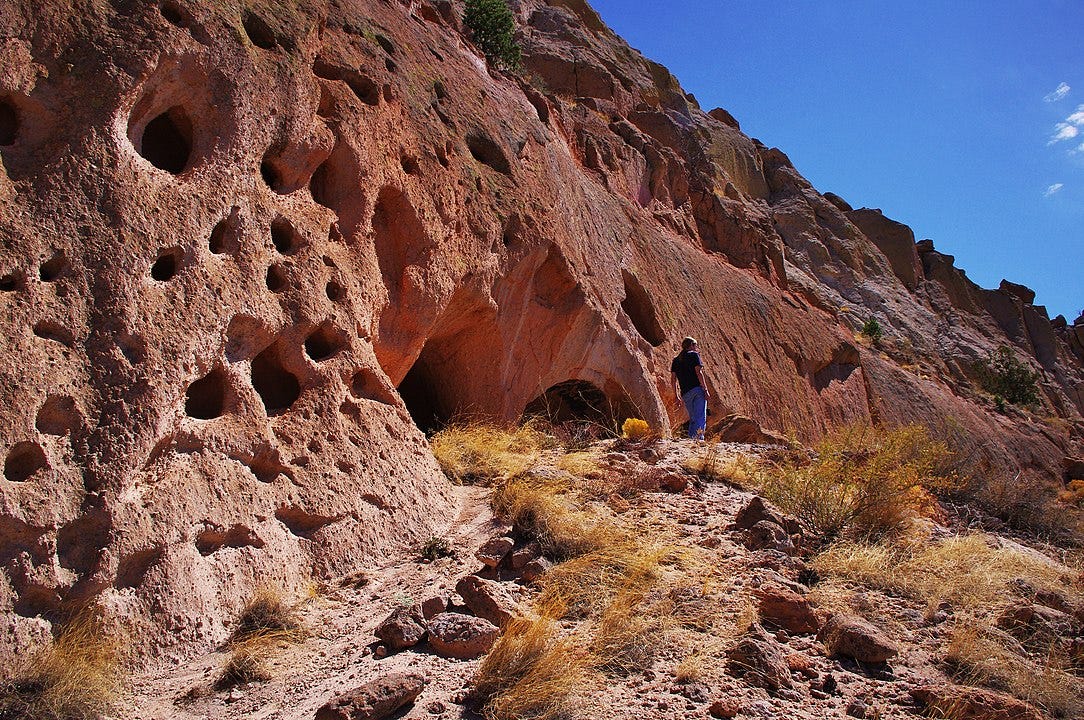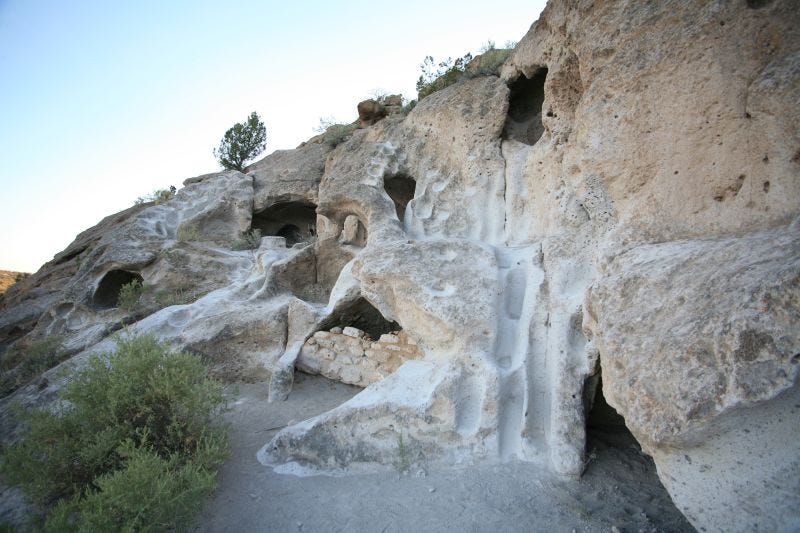Welcome to Postcards from New Mexico!
Two Sundays a month, I share beauty, stories, and culture from this region that has been my home since 2008.
The Jemez Mountains to the northwest of Santa Fe are full of natural and cultural treasures. Bandelier National Monument is high on the list for many visitors. But there is another place I’d like to share with you that will inspire awe and reverence.
Tsankawi is the ancestral home of the present-day Pueblo of San Ildefonso. It’s part of Bandelier but not as well known as the main section of the park (12 miles down the road). You’ll find fewer crowds here, but an equally impressive history and landscape.
One translation of the Tewa word Tsankawi (pronounced t’san – kah – wee) is “village between two canyons at the clump of sharp round cacti.” Tsankawi is situated on a narrow mesa almost a mile long but just a few hundred feet wide. The Jemez mountains are a very volcanic area and, as you’ll discover, much of the landscape here is comprised of volcanic tuff and solidified ash.
Indigenous Tewa people first settled here in the 12th century and gradually developed a village with about 350 rooms and an enclosed circular plaza carved into the earth. The one-and-a-half mile trail takes you across the mesa and through some of these living areas. You’ll walk along narrow paths that have been carved into the soft bedrock by footsteps over centuries of time, and you’ll scramble up ladders to reach tiers of the site. Along the way, you’ll see petroglyphs and cavates — human-excavated caves that provided shelter. The inhabitants of Tsankawi learned how to work with this arid climate and practiced the arts of dry harvesting and seed storage, and also sustained themselves by hunting local wildlife.
As you walk these trails you can almost hear the voices of the ancient ones as they planted crops and tended to their young ones.
The first time I visited Tsankawi was with Roshi Joan Halifax and a group of Upaya Zen Center retreatants who gathered to commemorate the 60th anniversary of the bombing of Hiroshima, in 2005. Los Alamos, where the atomic bomb was developed, is just a few miles away from Tsankawi. The contrast between the two places could not be more profound.
We were there in August and as we moved along the trails and huddled inside cliff dwellings, thunderstorms danced in the sky overhead. I mention this to remind you that this is an extremely elemental land, and it’s good to exercise cautious respect for the weather conditions if you visit. If there is a lot of winter snow, the pathways will not be walkable, and in the summer it’s important to keep an eye out for thunderstorms as there are many exposed parts of the trails.
Just as important as holding respect for the weather is holding respect for the place itself, and the Peoples who have lived here and still hold it as sacred. One Indigenous friend told me that for them, the Pajarito Plateau — where Tsankawi is located — is their church, their cathedral. While the mechanisms of settler-colonialism have technically put Tsankawi in the hands of the U.S. government, know that this is and always will be the Tewa homelands.
IF YOU GO:
How to get here from Santa Fe:
Head north on Highway 285 (the road that goes to Taos). Just past Pojoaque (about 12 miles north of Santa Fe), take State Highway 502 west to State Highway 4. Less than 1/4 of a mile past this turn, the parking lot for Tsankawi is on the left side of the road, just past the stop light.
Note that Tsankawi is significantly closer to Santa Fe than the main part of Bandelier National Monument, so you’ll have less driving (by about 24 miles round trip) if you only visit Tsankawi.
If you visit Bandelier National Monument during the same seven-day period, your admission to that park is also good for Tsankawi. If you only want to visit Tsankawi, look for the ticket kiosk inside the visitor’s facility just off the parking lot. A seven-day pass for a private vehicle is $25; there is no option for a single-day visit. The kiosk takes credit and debit cards, but no cash.
While this is not a large site nor a long trail, it can be easy to become disoriented to your surroundings here. Take note of where you started and the direction of the sun — that will help you find your way back to the parking area. You may see pottery sherds during your walk, please leave them where they are.
More reading:
The Forgotten Side of Bandelier: Archeology of the Tsankawi Ruins At Bandelier National Monument by Ryan Alexander Bloom
The Forgotten Side of Bandelier consolidates the archeology and anthropology of Tsankawi that was once scattered through many disparate sources and puts it in a larger context. If you’re planning to visit Tsankawi (or after you return from your visit) and are curious about the people who lived here and what life was like for them, this book is an excellent choice. The author is a music teacher who lives in Los Alamos and noticed there wasn’t a book that brought together all this information in one place, so he took it upon himself to do so.
Wish you were here!
Please consider becoming a paid subscriber and receive the following benefits:
A snail-mail postcard from New Mexico!
A beautiful e-book: 10 Hidden Gems of Northern New Mexico
Access to the “If you go/Local’s tips” section of certain posts where you’ll find valuable information to enhance your next journey to Northern New Mexico.
In acknowledgement of living on un-ceded Tewa lands, 10% of your subscription fee is donated to Native-led nonprofits doing good work in this region.
Postcards from New Mexico Bookshelf!
If you’re planning a visit to New Mexico or if you simply want to learn more about the history and culture of the place, I’ve put together a bookshelf on Bookshop.org, which is a lovely alternative to Amazon. Sales support authors and independent bookstores. I have an affiliate account with Bookshop and if you purchase a book through the links on this page, I receive a small percentage of the sale — so you’re also supporting me and Postcards from New Mexico!









Gorgeous images! I would have guessed "Tsankawi" to have been a Japanese word, but I would have been wrong. It's inspiring to hear about how the Tewa people who lived their adapted to the arid conditions. I also love your reminder to plan for and respect changing elemental conditions. They are very changeable here in Hawaii, too.
You can feel the sacredness of the land as you describe it here, Maia. New Mexico is such a uniquely beautiful place. Thank you for sharing your postcards.